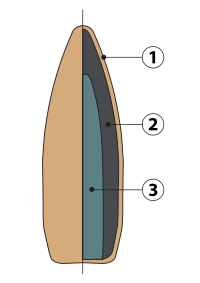
Photo from wikipedia
Abstract During more than one decade of studying initiation phenomenology numerous papers were published by the authors. A multitude of experimental data on hypervelocity impact initiation of plastic bonded high… Click to show full abstract
Abstract During more than one decade of studying initiation phenomenology numerous papers were published by the authors. A multitude of experimental data on hypervelocity impact initiation of plastic bonded high explosive charges by shaped charge jets (SCJ) and some data in the ordnance velocity impact regime obtained with STANAG projectiles and explosively formed projectiles (EFP) were generated. Amongst other findings the results showed that the established assumption that the critical stimulus is constant was wrong and that a new initiation model is needed taking the new results into account. Towards such a new model further investigation was necessary trying to make a link between the initiation phenomenology of shaped charge jet impacts in the hypervelocity regime and of projectile impacts in the lower velocity regime. To bridge the existing data gap a new approach was taken applying newly designed “simplified shaped charges” (SSC). This paper describes the way to this new approach and summarizes the related test results as well as their implications.
Journal Title: International Journal of Impact Engineering
Year Published: 2019
Link to full text (if available)
Share on Social Media: Sign Up to like & get
recommendations!